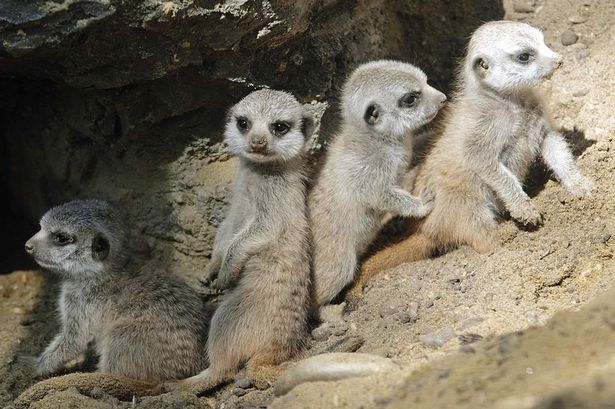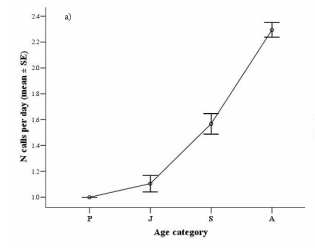Meerkat Surveyors
Biology 342 Fall 2014
Sofia Claesson
Lia Zallar
Ontogeny

7) Photo courtesy of Reuters
How do vocalizations and response to predator cues develop?
Young meerkats learn through observation of mature meerkats. In time, they develop the ability to make the appropriate variety of vocalizations in response to other stimuli (Hollén, 2006). Vocalizations change over a meerkat's lifetime depending on the relative urgency of the forms of communication. They initially learn alarm calls signaling predators before learning other vocalizations. Juvenile meerkats are more adept at producing signals in response to aerial predators than other types of predators. This is because aerial predators are more dangerous and encountered at a higher frequency.
8) Figure courtesy of Hollén, 2006
 Younger meerkats generally produce fewer calls than their adult counterparts. As meerkats develop, their rate of calls increases, suggesting it is a learned behavior. The figure to the left shows this increase from pup (P), juvenile (J), sub-adult (S), to adult (A). The number of calls per day is on the Y axis.
Younger meerkats generally produce fewer calls than their adult counterparts. As meerkats develop, their rate of calls increases, suggesting it is a learned behavior. The figure to the left shows this increase from pup (P), juvenile (J), sub-adult (S), to adult (A). The number of calls per day is on the Y axis.
Alertness is an important factor of effective calls and communication, and it develops throughout the first year of the meerkat's life. Juvenile meerkats have been shown to react differently to alarm calls compared to adults. The figure below shows that meerkat pups had a shorter reaction time to alarm calls compared to adults. However, meerkat pups resumed foraging behavior sooner after the alarm call than the adults and spent less time scanning for predators (Hollén, 2006).
9) Figure courtesy of Hollén, 2006
